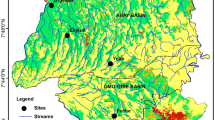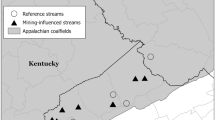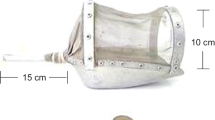Abstract
Small headwater streams constitute a large proportion of the river channel network in many parts of the world. In this study, two multihabitat kick sampling methods (60-second and 20-second) were compared across 10 small headwater streams in the southwest and east of Ireland in spring and summer 2009 to determine the influence of sampling on various benthic macroinvertebrates in headwater streams. The performance of each method, over time and replication, was examined using a range of benthic macroinvertebrate metrics, as well as the community composition and structure recorded by both methods. The ability to recruit taxa, as well as the field sampling and laboratory processing effort required for each method, was also assessed. Results indicated that both kick sampling methods generally recorded similar metric scores with the exception of taxonomic richness (t = 180 s and n = 9 replicates test) where the 20-second kicks consistently out preformed those calculated for the 60-second kicks. All other metrics compared generally performed equally as well regardless of the method used. Multivariate analysis of macroinvertebrate community assemblage, using SIMPROF, RELATE and CS-SMC analyses, further highlighted the high similarity in the macroinvertebrate assemblage recorded between both methods. Finally, the 20-second kicks recruited taxa as efficiently as 60-second kicks samples so long as replication was equal but required less sampling effort (NSE) and processing time. Therefore, the shorter 20-second kicks can be used to assess the ecological health of headwater streams, provided that adequate replication is adopted, resulting in significant effort, cost and time savings.



Similar content being viewed by others
References
Alexander, R. B., E. W. Boyer, R. A. Smith, G. E. Schwarz & R. B. Moore, 2007. The role of headwater streams in downstream water quality. Journal of the American Water Resources Association 43: 41–59.
Anonymous, 2005. Western River Basin District Project: Small Streams Risk Score. Environmental Protection Agency, Ireland.
AQEM Consortium, 2006. ASTERICS: AQEM/STAR Ecological River Classification System, version 3.01 [available on internet at http://www.fliessgewaesserbewertung.de/download/berechnungS].
Barbour, M. T. & J. Gerritsen, 1996. Subsampling of benthic samples: a defense of the fixed-count method. Journal of the North American Benthological Society 15: 386–391.
Becerra Jurado, G., M. Materson, R. Harrington & M. Kelly-Quinn, 2008. Evaluation of sampling methods for macroinvertebrate biodiversity estimation in heavily vegetated ponds. Hydrobiologia 597: 97–107.
Bradley, D. C. & S. J. Ormerod, 2002a. Evaluating the precision of kick-sampling in upland streams for assessment of long-term change: the effects of sampling effort, habitat and rarity. Archive für Hydrobiologia 155: 199–221.
Bradley, D. C. & S. J. Ormerod, 2002b. Long-term effects of catchment liming on invertebrates in upland streams. Freshwater Biology 47: 161–171.
Brua, R. B., J. M. Culp & G. A. Benoy, 2011. Comparison of benthic macroinvertebrate communities by two methods: Kick- and U-net sampling. Hydrobiologia 658: 293–302.
Cairns, J. & J. R. Pratt, 1993. A history of monitoring using benthic macroinvertebrates. In Rosenberg, D. M. & V. H. Resh (eds), Freshwater Biomonitoring and Benthic Macroinvertebrates. Chapman and Hall, New York, USA: 10–27.
Callanan, M. C., J.-R. Baars & M. Kelly-Quinn, 2008. Critical influence of seasonal sampling on the ecological quality assessment of small headwater streams. Hydrobiologia 610: 245–255.
Callanan, M. C., J.-R. Baars & M. Kelly-Quinn, 2009. Comparison of the macroinvertebrate communities of seepage and lake-fed headwater streams. Verhandlungen Internationale Vereingung fur Limnologie 30: 685–689.
Cao, Y., D. D. Williams & N. E. Williams, 1998. How important are rare species in aquatic community ecology and bioassessment? Limnology and Oceanology 43: 1403–1409.
Cao, Y., D. D. Williams & D. P. Larsen, 2002. Comparison of ecological communities: the problem of sample representativeness. Ecological Monographs 72: 41–56.
Cao, Y., C. P. Hawkins & A. W. Storey, 2005. A method for measuring the comparability of different sampling methods used in biological surveys: implications for data integration and synthesis. Freshwater Biology 50: 1105–1115.
Carter, J. L. & V. H. Resh, 2001. After site selection and before data analysis: sampling, sorting, and laboratory procedures used in stream benthic macroinvertebrate monitoring programs by USA state agencies. Journal of North American Benthological Society 20: 658–682.
Clarke, K. R. & R. N. Gorley, 2006. PRIMER v6: User Manual/Tutorial. PRIMER-E Ltd, Plymouth, UK.
Clarke, R. T., M. T. Furse, R. J. M. Gunn, J. M. Winder & J. F. Wright, 2002. Sampling variation in macroinvertebrate data and implications for river quality indices. Freshwater Biology 47: 1735–1751.
Colwell, R. K., 2005. EstimateS: statistical estimation of species richness and shared species from samples. Version 7.5. User’s guide and application published at: http://purl.oclc.org/estimates.
Cummins, K. W., 1992. Catchment characteristics and river ecosystems. In Boon, P. J., P. Calow & G. E. Petts (eds), River Conservation and Management. Wiley, Chichester, UK: 125–135.
Dangles, O., B. Malmqvist & H. Laudon, 2004. Naturally acid freshwater ecosystems are diverse and functional: evidence from boreal streams. Oikos 104: 149–155.
Davy-Bowker, J., J. F. Murphy, G. P. Rutt, J. E. C. Steel & M. T. Furse, 2005. The development and testing of a macroinvertebrate biotic index for detecting the impact of acidity on streams. Archiv für Hydrobiologie 163: 383–403.
Diamond, J. M., M. T. Barbour & J. B. Stribling, 1996. Characterizing and comparing bioassessment methods and their results: a perspective. Journal of the North American Benthological Society 15: 713–727.
Dodds, W. K. & R. M. Oakes, 2008. Headwater influences on downstream water quality. Environmental Management 41: 367–377.
Duggan, I. C., I. K. G. Boothroyod & D. A. Speirs, 2007. Factors affecting the distribution of stream macroinvertebrates in geothermal areas: Taupo Volcanic Zone, New Zealand. Hydrobiologia 592: 235–247.
Feeley, H. B., C. Kerrigan, P. Fanning, E. Hannigan & M. Kelly-Quinn, 2011. Longitudinal extent of acidification effects of plantation forest on benthic macroinvertebrate communities in soft water streams: evidence for localised impact and temporal ecological recovery. Hydrobiologia 671: 217–226.
Fitzhugh, R. D., T. Furman, J. R. Webb, B. J. Cosby & C. T. Driscoll, 1999. Longitudinal and seasonal patterns of stream acidity in a headwater catchment on the Appalachian Plateau, West Virginia, U.S.A. Biogeochemistry 47: 39–62.
Friberg, N., L. Sandin, M. T. Furse, S. E. Larsen, R. T. Clarke & P. Haase, 2006. Comparison of macroinvertebrate sampling methods in Europe. Hydrobiologia 566: 365–378.
Furse, M. T., 2000. The application of RIVPACS procedures in headwater streams—an extensive and important national resource. In Wright, J. F., D. W. Sutcliffe & M. T. Furse (eds), Assessing the Biological Quality of Freshwaters. RIVPACS and Other Techniques. Freshwater Biological Association, Cumbria, UK: 79–91.
Furse, M. T., J. F. Wright, P. D. Armitage & D. Moss, 1981. An appraisal of pond-net samples for biological monitoring of lotic macroinvertebrates. Water Research 15: 679–689.
Gordi, T. & H. Khamis, 2004. Simple solution to a common statistical problem: interpreting multiple tests. Clinical Therapeutics 26: 780–786.
Growns, J. E., B. E. Chessman, J. E. Jackson & D. G. Ross, 1997. Rapid assessment of Australian rivers using macroinvertebrates: cost and efficiency of 6 methods of sample processing. Journal of the North American Benthological Society 16: 682–693.
Growns, I., C. Schiller, N. O’ Connor, A. Cameron & B. Gray, 2006. Evaluation of four live-sorting methods for use in rapid biological assessments using macroinvertebrates. Environmental Monitoring and Assessment 117: 173–192.
Guérold, F., J.-P. Boudot, G. Jacquemin, D. Vein, D. Merlet & J. Rouiller, 2000. Macroinvertebrate community loss as a result of headwater stream acidification in the Vosges Mountains (N-E France). Biodiversity and Conservation 9: 767–783.
Haase, P., S. Lohse, S. Pauls, K. Schindehutte, A. Sundermann, P. Rolauffs & D. Hering, 2004a. Assessing streams in Germany with benthic invertebrates: development of a practical and standardised protocol for macroinvertebrate sampling and sorting. Limnologica 34: 349–365.
Haase, P., S. Pauls, A. Sundermann & A. Zenker, 2004b. Testing different sorting techniques in macroinvertebrate samples from running waters. Limnologica 34: 366–378.
Haase, P., J. Murray-Bligh, S. Lohse, S. Pauls, A. Sundermann, R. Gunn & R. Clarke, 2006. Assessing the impact of error in sorting and identifying macroinvertebrate samples. Hydrobiologia 566: 505–521.
Haase, P., S. U. Pauls, K. Schindehütte & A. Sundermann, 2010. First audit of macroinvertebrate samples from an EU Water Framework Directive monitoring program: human error greatly lowers precision of assessment results. Journal of the North American Benthological Society 29: 1279–1291.
Hannaford, M. J. & V. H. Resh, 1995. Variability in macroinvertebrate rapid-bioassessment surveys and habitat assessments in a Northern California stream. Journal of the North American Benthological Society 14: 430–439.
Hawkes, H. A., 1997. Origin and development of the biological monitoring working party score system. Water Research 32: 964–968.
Heino, J., T. Muotka, Riku. Paavola, H. Hämäläinen & E. Koshkenniemi, 2002. Correspondence between regional delineations and spatial patterns in macroinvertebrate assemblages of boreal headwater streams. Journal of the North American Benthological Society 21: 397–413.
Holm, S., 1979. A simple sequentially rejective multiple test procedure. Scandinavian Journal of Statistics 6: 65–70.
Kavanagh, P., R. Walsh & A. Walsh, 2006. Further Characterisation of Small Streams and Development of a New Small Stream Risk Score (SSRS) Project Output Report. ESB International Limited, Dublin: 1–46.
Kelly-Quinn, M., D. Tierney, C. Coyle & J. J. Bracken, 1996. Factors affecting the susceptibility of Irish soft-water streams to forest-mediated acidification. Fisheries Management and Ecology 3: 287–301.
Kelly-Quinn, M., R. Cruikshanks, J. Johnson, R. Matson, J.-R. Baars & M. Bruen, 2008. Forestry & Surface-water Acidification (FORWATER). Report to the Western River Basin District [available on internet at http://www.wfdireland.ie/docs/22_ForestAndWater/].
Kerans, B. L., J. R. Karr & S. A. Ahlstedt, 1992. Aquatic invertebrate assemblages: spatial and temporal differences among sampling protocols. Journal of the North American Benthological Society 11: 377–390.
Kibichii, S., J.-R. Baars & M. Kelly-Quinn, 2009. Optimising sample volume and replicates using the Bou-Rouch method for the rapid assessment of hyporheic fauna. Marine & Freshwater Research 60: 83–96.
Kowalik, R. A., D. M. Cooper, C. D. Evans & S. J. Ormerod, 2007. Acidic episodes retard the biological recovery of upland British streams from chronic acidification. Global Change Biology 13: 2439–2452.
Lenat, D. R., 1988. Water quality assessment of streams using a qualitative collection method for benthic macroinvertebrates. Journal of the North American Benthological Society 7: 222–233.
Leopold, L. B., M. G. Wolman & J. P. Miller, 1964. Fluvial Processes in Geomorphology. Freeman and Co., San Francisco and London.
Lepori, F., A. Barbieri & S. J. Ormerod, 2003. Effects of episodic acidification on macroinvertebrate assemblages in Swiss Alpine streams. Freshwater Biology 48: 1873–1885.
Mackey, A. P., D. A. Cooling & A. D. Berrie, 1984. An evaluation of sampling strategies for qualitative surveys of macroinvertebrates in rivers, using pond-nets. Journal of Applied Ecology 21: 515–534.
Magurran, A. E., 2004. Measuring Biological Diversity. Blackwell Publishing, Oxford, UK.
Mason, C., 2002. Biology of Freshwater Pollution, 4th ed. Pearson Education Limited, Essex, UK.
McGarrigle, M. L. & J. Lucey, 1983. Biological monitoring of freshwaters. Irish Journal of Environmental Science 2: 1–18.
Metcalfe, J. L., 1989. Biological water quality assessment of running waters based on macroinvertebrate communities: history and present status in Europe. Environmental Pollution 60: 101–139.
Meyer, J. L., D. L. Strayer, J. B. Wallace, S. L. Eggert, G. S. Helfman & N. E. Leonard, 2007. The contribution of headwater streams to biodiversity in river networks. Journal of the American Water Resources Association 43: 86–103.
Nichols, S. J. & R. H. Norris, 2006. River condition assessment may depend on the sub-sampling method: field live-sort versus laboratory sub-sampling of invertebrates for bioassessment. Hydrobiologia 572: 195–213.
Nijboer, R. C., P. F. M. Verdonschot & D. C. Van Der Werf, 2005. The use of indicator taxa as representatives of communities in bioassessment. Freshwater Biology 50: 1427–1440.
Oertli, B., D. A. Joye, E. Castella, R. Juge, A. Lehmann & J. B. Lachavanne, 2005. PLOCH: a standardized method for sampling and assessing the biodiversity in ponds. Aquatic Conservation: Marine and Freshwater Ecosystems 15: 665–679.
Ormerod, S. J. & I. Durance, 2009. Restoration and recovery from acidification in upland Welsh streams over 25 years. Journal of Applied Ecology 46: 164–174.
Pinder, L. C. V., M. Ladle, T. Gledhill, J. A. B. Bass & A. M. Matthews, 1987. Biological surveillance of water quality – I. A comparison of macroinvertebrate surveillance methods in relation to assessment of water quality, in a chalk stream. Archive für Hydrobiologia 109: 207–226.
Quinn, G. P. & M. J. Keough, 2002. Experimental design and data analysis for biologists. Cambridge University Press, Cambridge, UK.
Resh, V. H., 1994. Variability, accuracy, and taxonomic costs of rapid assessment approaches in benthic macroinvertebrate biomonitoring. Italian Journal of Zoology 61: 375–383.
Resh, V. H. & J. K. Jackson, 1993. Rapid assessment approaches to biomonitoring using benthic macroinvertebrates. In Rosenberg, D. M. & V. H. Resh (eds), Freshwater Biomonitoring and Benthic Macroinvertebrates. Chapman and Hall, New York, USA: 195–233.
Schmera, D. & T. Erős, 2010. The role of sampling effort, taxonomical resolution and abundance weight in multivariate comparison of stream dwelling caddisfly assemblages collected from riffle and pool habitats. Ecological Indicators 11: 230–239.
Smith, J. J. & A. Lyle, 1979. Distribution of Freshwaters in Great Britain. Institute of Terrestrial Ecology, Edinburgh: 1–44.
StatSoft Inc., 2005. STATISTICA (data analysis software system), Version 7.1 [available on internet at www.statsoft.com].
Strahler, A. N., 1957. Quantitative analysis of watershed geomorphology. Transactions of the American Geophysical Union 38: 193–920.
Van Sickle, J., 1997. Using mean similarity dendrograms to evaluate classification. Journal of Agricultural, Biological, and Environmental Statistics 2: 370–388.
Ventura, M. & D. Harper, 1996. The impacts of acid precipitation mediated by geology and forestry upon upland stream invertebrate communities. Archiv für Hydrobiologie 138: 161–173.
Vinson, M. R. & C. P. Hawkins, 1996. Effects of sampling area and subsampling procedure on comparisons of taxa richness among streams. Journal of North American Benthological Society 15: 392–399.
Vlek, H. E., F. Ŝporka & I. Krno, 2006. Influence of macroinvertebrate sample size on bioassessment of streams. Hydrobiologia 566: 523–542.
Wigington, P. J., Jr., J. P. Baker, D. R. DeWalle, W. A. Kretser, P. S. Murdoch, H. A. Simonin, J. Van Sickle, M. K. McDowell, D. V. Peck & W. R. Barchet, 1996. Episodic acidification of small streams in the Northeastern United States: episodic response project. Ecological Applications 6: 374–388.
Wright, J., 1995. Development and use of a system predicting the macroinvertebrate fauna in flowing waters. Australian Journal of Ecology 20: 181–197.
Acknowledgments
This study was funded by the HYDROFOR project co-sponsored by the Department of Agriculture, Fisheries and Food, and the Environmental Protection Agency under the STRIVE Program 2007–2013. Thanks are due to Mr. Juan Pablo Martin García, Ms. Letizia Cocchiglia, Dr. Edel Hannigan and Dr. Maria Callanan for their help at different stages of this study, and to Dr. Jon Yearsley for his statistical help. The authors wish to thank the anonymous reviewers for their helpful comments and invaluable suggestions which greatly helped in improving this article.
Author information
Authors and Affiliations
Corresponding author
Additional information
Handling editor: David Dudgeon
Rights and permissions
About this article
Cite this article
Feeley, H.B., Woods, M., Baars, JR. et al. Refining a kick sampling strategy for the bioassessment of benthic macroinvertebrates in headwater streams. Hydrobiologia 683, 53–68 (2012). https://doi.org/10.1007/s10750-011-0940-9
Received:
Revised:
Accepted:
Published:
Issue Date:
DOI: https://doi.org/10.1007/s10750-011-0940-9




